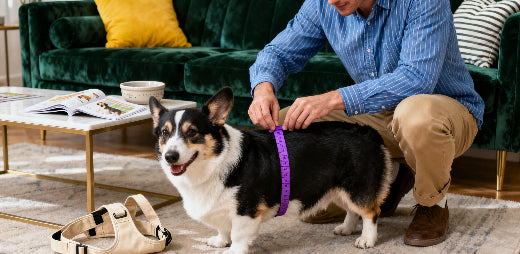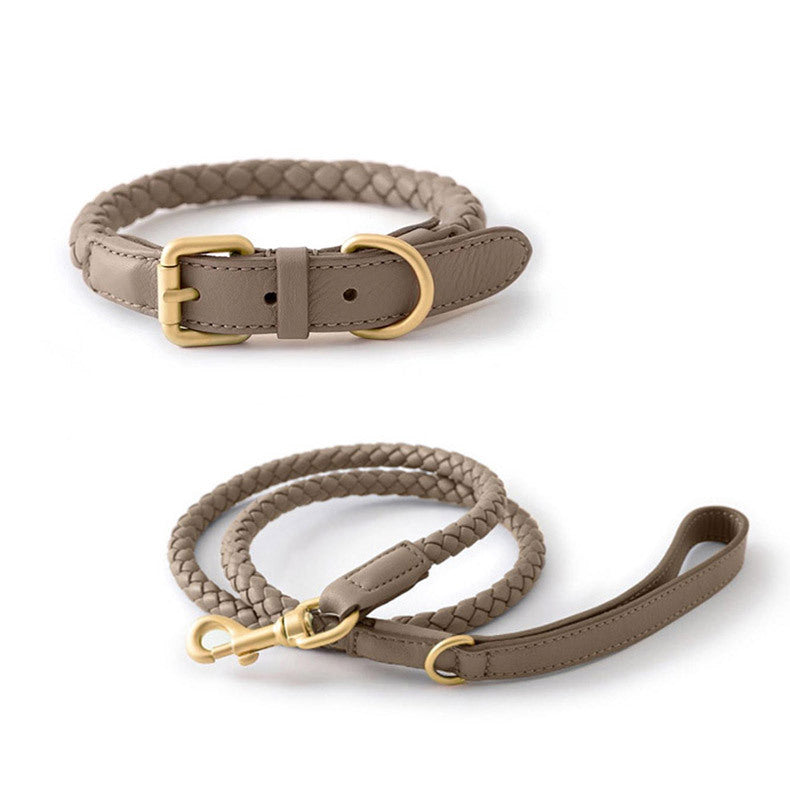
How to Measure a Dog for a Harness
Share
Finding the right harness for your dog begins with knowing the correct size. A harness that fits properly keeps your dog safe, comfortable, and easy to control. If the harness is too loose, a dog can slip out of it; if it’s too tight, it can cause rubbing and discomfort.
Here’s a simple guide on how to measure a dog for a harness so you can get the perfect fit every time.

Why Proper Measurement Matters
Every dog’s body shape is unique — even within the same breed. That’s why guessing a size by eye or weight rarely works. Accurate measurements help you:
- Prevent chafing or rubbing under the armpits
- Avoid neck strain and restricted movement
- Ensure the harness stays securely in place
- Keep your dog relaxed and safe during walks
What do you need
To measure your dog correctly, prepare these items:
- Soft measuring tape (or a string and ruler)
- Pen and paper or your phone to record numbers
- A treat or toy to keep your dog calm
Make sure your dog is standing upright on all four legs while measuring. Measurements taken while sitting or lying down can be inaccurate.
Step-by-Step: How to Measure a Dog for a Harness
Measure the Chest Girth
The chest girth, or body circumference, is the most important measurement for harness sizing.
Wrap the tape around the widest part of your dog’s chest, just behind the front legs.
Keep the tape snug but not tight — you should be able to slide two fingers between the tape and the body.
Write down the number in inches or centimeters.
Example: If the chest girth is 22 inches, look for a harness labeled for 20–24" chest size.
Measure the Neck
The neck measurement helps ensure the harness won’t be too tight around the collar area. How to measure the neck for a dog harness?
Place the tape around the base of the neck, where the collar usually rests.
The tape should fit comfortably, not digging into the skin.
Note the measurement.

Measure the Back Length (Optional)
Some harness types, especially full-body or step-in models, may also require the back length.
Measure from the base of the neck to the base of the tail.
This step is optional, but it helps for certain designs or custom harnesses.
Double-Check Your Numbers
Dogs move a lot, and small changes can affect results. Take each measurement two or three times and use the average.
If your dog’s size falls between two harnesses, choose the larger one — it’s easier to adjust down than to stretch a smaller size.
How to Use a Dog Harness Size Chart
Once you have all the numbers, compare them to the dog harness size chart provided by the brand you’re purchasing from.
| Size | Chest Girth (in) | Neck (in) | Example Breeds |
|---|---|---|---|
| XS | 10–15 | 8–12 | Toy Poodle, Chihuahua |
| S | 14–20 | 10–16 | Dachshund, Pug |
| M | 18–28 | 14–20 | Beagle, Cocker Spaniel |
| L | 26–38 | 18–26 | Border Collie, Labrador |
| XL | 35–45 | 22–30 | Husky, Golden Retriever |
Common Mistakes to Avoid
Many sizing issues come from small measurement errors. Keep these points in mind:
- Don’t measure while your dog is sitting or curled up
- Avoid pulling the tape too tight
- Allow a little extra space for thick or curly fur
- Don’t rely on weight alone to pick a size
Remember: adjustable straps can fine-tune the fit, but wrong measurements can’t be fixed

Tips for Puppies and Special Breeds
Puppies: Re-measure every few months as they grow quickly. Adjustable harnesses are best.
Fluffy dogs: Add a small margin to account for thick fur.
Broad-chested breeds (like Bulldogs): Focus on chest girth for the best fit.
Fitting the Harness After Measuring
Once the harness arrives, follow these steps:
Loosen all straps before putting it on.
Slide it over your dog’s head or step the legs through, depending on the type.
Adjust each strap evenly until snug.
Check that you can fit two fingers under each strap.
Watch your dog walk and make sure the harness doesn’t shift, rub, or limit movement.
If the harness moves excessively, tighten slightly; if it feels restrictive, loosen it.

Final Advice
Getting accurate measurements saves time, avoids returns, and keeps your dog comfortable. Take your time, measure carefully, and compare the results to a dog harness size chart before purchasing.
Once you find the right fit, you’ll notice a difference in how confidently and comfortably your dog moves on walks.
Ready to size your dog? Use this guide, grab your measuring tape, and explore our [Dog Harness Collection] for adjustable, safe, and durable options that fit every pup.

